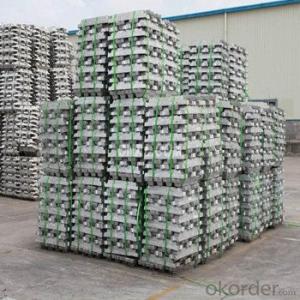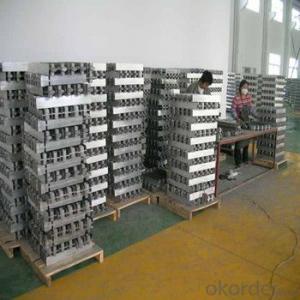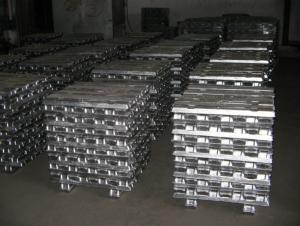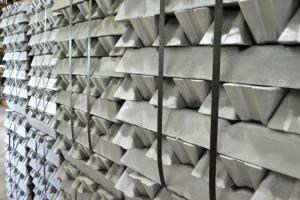Aluminum Pig/Ingot With Good Price From Mills
- Loading Port:
- China main port
- Payment Terms:
- TT OR LC
- Min Order Qty:
- 1000 m.t.
- Supply Capability:
- 100000 m.t./month
OKorder Service Pledge
OKorder Financial Service
You Might Also Like
Pure Aluminum Pig/Ingot Used for Industry
1.Structure of Aluminum Pig/Ingot
A material that has been cast into a shape in order to be transported and processed easier than in an unprocessed form. An ingot is typically rectangular in shape, which allows it to be stacked. Ingots are most commonly associated with metals, with ingots of gold held in the vaults of banks and brokerages being popular images.
Aluminum Ingot is with the AL as the main chemical composition.Aluminum Ingot is used for industry,such as automobile,pinning and weaving,electron broadly and so on. Aluminum Ingot has the following advantages: easy control and operation, fast melting.
2.Main Features of the Aluminum Pig/Ingot
•High Purity
•Easy control and operation
•High strength
•Fast melting
•Competitive price
•Best Service
3.Aluminum Pig/Ingot Images


4.Aluminum Pig/Ingot Specification
Grade | Chemical Composition % | |||||||||
Al≥ | impurities ≤ | |||||||||
Si | Fe | Cu | Ga | Mg | Zn | Mn | others | Sum | ||
Al99.9 | 99.90 | 0.50 | 0.07 | 0.005 | 0.02 | 0.01 | 0.025 | - | 0.010 | 0.10 |
Al99.85 | 99.85 | 0.80 | 0.12 | 0.005 | 0.03 | 0.02 | 0.030 | - | 0.015 | 0.15 |
Al99.7 | 99.70 | 0.10 | 0.20 | 0.010 | 0.03 | 0.02 | 0.030 | - | 0.030 | 0.30 |
Al99.6 | 99.60 | 0.16 | 0.25 | 0.010 | 0.03 | 0.03 | 0.030 | - | 0.030 | 0.40 |
Al99.5 | 99.50 | 0.22 | 0.30 | 0.020 | 0.03 | 0.05 | 0.050 | - | 0.030 | 0.50 |
Al99.00 | 99.00 | 0.42 | 0.50 | 0.020 | 0.03 | 0.05 | 0.050 | - | 0.050 | 1.00 |
5.FAQ of Aluminum Pig/Ingot
We have organized several common questions for our clients,may help you sincerely:
①How about your company?
A big and famous and professional manufacturer & supplier of Aluminum Pig/Ingot, is one of the one of the large-scale professional investment Aluminum Pig/Ingot production bases in China.It have focuses on producing the Aluminum Pig/Ingot production for many years and gotten rich experience.Annually lagrge amount of Aluminum Pig/Ingot production are exported to markets in Europe,America and Japan. The quality and service have also gotten OEM service is available according to customer’s requirements.
②How to guarantee the quality of the products?
We have established the international advanced quality management system,every link from raw material to final product we have strict quality test;We resolutely put an end to unqualified products flowing into the market. At the same time, we will provide necessary follow-up service assurance.
③How long can we receive the product after purchase?
In the purchase of product within three working days, We will arrange the factory delivery as soon as possible. The pecific time of receiving is related to the state and position of customers.Commonly 7 to 10 working days can be served.
- Q: How much capital do I need to invest in the recycled aluminium ingot?
- This mainly depends on how much money you scale, there are local to not to do this, I am here in Foshan now, we're not here to make this move to distant places to engage in equipment, don't need how much, I have many friends in this, but now we're not here to do
- Q: What is the weight of a standard aluminum ingot?
- The weight of a standard aluminum ingot can vary, but it is typically around 50 pounds (22.7 kilograms) or 25 kilograms.
- Q: Who knows where needs aluminium ingot, aluminium powder, aluminium grain?
- Relative density 2.70. Melting point 660 DEG C. Boiling point 2327 DEG C. Aluminum is the third largest in the earth's crust, second only to oxygen and silicon, and is the most abundant metal element in the earth's crust. The development of the three important industries, aviation, architecture and automobile, requires that the material characteristics have the unique properties of aluminum and its alloys, which will greatly benefit the production and application of the new metal aluminum. Applications are very extensive.
- Q: Does the pure aluminium ingot need to be removed in addition to the slag after melting?
- Specific look at the accuracy of your die-casting, strict requirements can not be removed, reducing costs, more competitive
- Q: What are the basic equipments for the production of aluminium ingots?
- If you want to match the very homogeneous ingot aluminum melting furnace, automatic machine, automatic folding spindle machine, environmental protection equipment, forklift, spectrum analyzer, loadometer, refining machine etc..
- Q: Aluminum profile manufacturers which good? How to choose?
- Explain as follows: preparing goods, recruit a few operator, big online promotion can be opened. Those who are often hurt are our buyers. Miss wiring mostly do not know how to use, only know the unit price. How to use to meet customer needs; how to make the most cost-effective; in different venues that kind of connection is the best; these are they can not answer accurately. Only know the cheapest and recommended profile connection the cheapest; this connection is the lowest cost, but the cost of artificial, a connection is the weakest, aluminum convenience wouldn't be reflected, and will bring much trouble for the future reconstruction. But the wiring girl will push it one way.
- Q: What are the different extrusion processes for aluminum ingots?
- Aluminum ingots can undergo various extrusion processes, each with distinct characteristics and applications. Some commonly employed methods for aluminum extrusion are: 1. The most widely used process for aluminum ingots is direct extrusion. It involves heating the ingot and pushing it through a die using a ram or hydraulic press. The material flows in the same direction as the ram, resulting in a continuous profile with a consistent cross-section. 2. Indirect extrusion, on the other hand, utilizes a stationary die and a hollow ram to force the ingot through the die. The material flows in the opposite direction of the ram, resulting in a profile with superior surface finish and improved mechanical properties. 3. Impact extrusion is employed to create hollow shapes like tubes or containers. It entails striking a punch against the ingot, causing the metal to flow around the punch and form the desired shape. Impact extrusion is ideal for high-volume production of small parts. 4. Unlike the aforementioned processes that involve heating, cold extrusion is conducted at room temperature. The ingot is placed in a die and compressed using a hydraulic press or mechanical force. Cold extrusion is particularly useful for producing intricate shapes with precise tolerances and excellent surface finish. 5. Hydrostatic extrusion necessitates placing the ingot in a sealed chamber filled with a liquid, typically oil or water. Pressure is exerted on the liquid, which then applies even pressure on the ingot. This method is often employed for extruding alloys with low ductility or complex shapes. Each extrusion process presents its own advantages and limitations, and the choice depends on factors such as the desired product shape, material properties, production volume, and cost considerations.
- Q: What elements do alloy die casting ingots require?
- Zinc can improve fluidity, increase brittleness and reduce corrosion resistance in aluminum alloy. Therefore, zinc content should be controlled in the specified range. As for the ZL401 alloy with high zinc content, it has better casting performance and mechanical properties, and the cutting process is better.
- Q: Does aluminum ingots produced without aluminum ore belong to metal smelting?
- Metal smelting is the process of changing metal from a compound to a free state.Metal elements were obtained by reduction reaction with metal oxides such as carbon, carbon monoxide, hydrogen and other reducing agents at high temperature.
- Q: How can I make aluminium ingots for cans?
- As for the procedures, just started, can not do not do, not encourage illegal business, but then you should make the cash flow on the blade, so you have to consider your experience to set up the factory scale, and then targeted the related formalities, in fact you know some of the company law and policy development and Reform Commission, there will be a natural answer. Your own understanding of the industry is the most important.
Send your message to us
Aluminum Pig/Ingot With Good Price From Mills
- Loading Port:
- China main port
- Payment Terms:
- TT OR LC
- Min Order Qty:
- 1000 m.t.
- Supply Capability:
- 100000 m.t./month
OKorder Service Pledge
OKorder Financial Service
Similar products
Hot products
Hot Searches




























